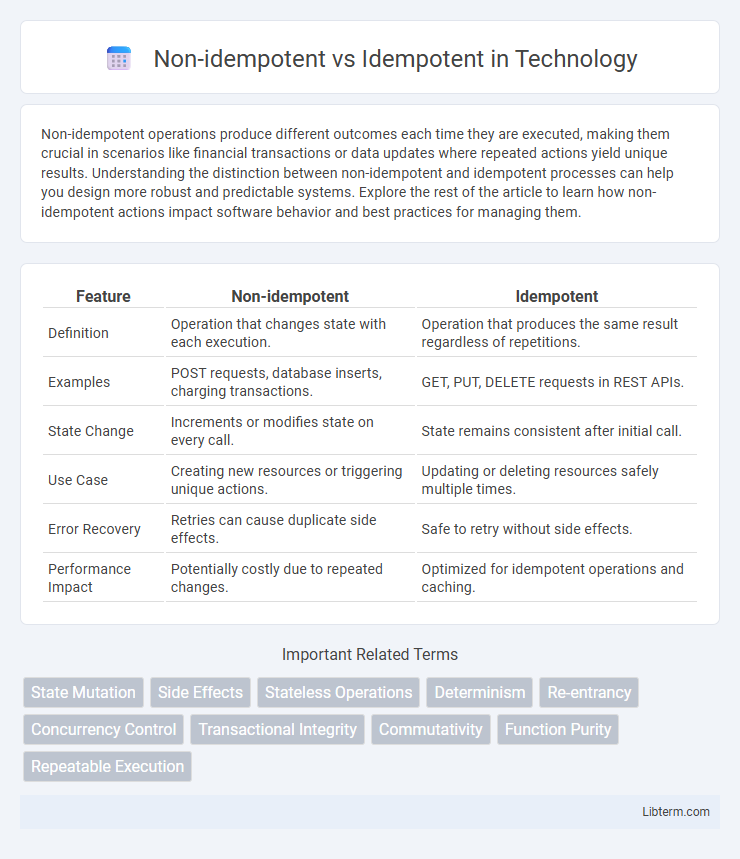Non-idempotent operations produce different outcomes each time they are executed, making them crucial in scenarios like financial transactions or data updates where repeated actions yield unique results. Understanding the distinction between non-idempotent and idempotent processes can help you design more robust and predictable systems. Explore the rest of the article to learn how non-idempotent actions impact software behavior and best practices for managing them.
Table of Comparison
| Feature | Non-idempotent | Idempotent |
|---|---|---|
| Definition | Operation that changes state with each execution. | Operation that produces the same result regardless of repetitions. |
| Examples | POST requests, database inserts, charging transactions. | GET, PUT, DELETE requests in REST APIs. |
| State Change | Increments or modifies state on every call. | State remains consistent after initial call. |
| Use Case | Creating new resources or triggering unique actions. | Updating or deleting resources safely multiple times. |
| Error Recovery | Retries can cause duplicate side effects. | Safe to retry without side effects. |
| Performance Impact | Potentially costly due to repeated changes. | Optimized for idempotent operations and caching. |
Understanding Idempotent Operations
Idempotent operations produce the same result regardless of how many times they are executed with the same input, ensuring stability and predictability in system behavior. In contrast, non-idempotent operations can lead to different outcomes or side effects with each execution, which may cause inconsistencies or errors in distributed systems or APIs. Understanding idempotent operations is crucial for designing reliable RESTful services because they allow safe retries without unintended consequences, improving fault tolerance and client-server communication.
Defining Non-Idempotent Operations
Non-idempotent operations produce different outcomes or side effects each time they are executed, making repeated execution potentially harmful or inconsistent. Examples include financial transactions like withdrawals or placing orders, where each request alters the system state uniquely. Understanding non-idempotence is crucial for designing APIs and systems that prevent unintended consequences from duplicate requests or retries.
Key Differences: Idempotent vs Non-Idempotent
Idempotent operations produce the same result regardless of how many times they are executed, ensuring stability and predictability in distributed systems, such as HTTP methods GET and PUT. Non-idempotent operations, like POST and DELETE, can cause different outcomes with repeated execution, often modifying server state or creating multiple resources. Understanding these distinctions is critical for designing fault-tolerant APIs and avoiding unintended side effects during retries or network failures.
Importance of Idempotency in System Design
Idempotency is crucial in system design for ensuring reliability, especially in distributed systems handling retries and network failures. Idempotent operations, which produce the same result regardless of how many times they are executed, prevent duplicate transactions and maintain data consistency. Non-idempotent operations, on the other hand, risk data corruption or unintended side effects when repeated, making idempotency a fundamental principle for building robust APIs and fault-tolerant services.
Examples of Idempotent Operations
Idempotent operations produce the same result regardless of how many times they are executed, exemplified by HTTP methods like GET, PUT, and DELETE. For instance, an HTTP PUT request updating a resource's state will consistently yield the same resource representation without unintended side effects on repeated calls. Database commands such as setting a user's status to active also exemplify idempotence, as executing the command multiple times maintains the user's state without duplication or error.
Common Use Cases for Non-Idempotent Actions
Non-idempotent actions are commonly used in scenarios where each request causes a unique or cumulative change, such as creating new database records, processing financial transactions, or submitting orders. These actions often modify state in ways that cannot be repeated without side effects, making them critical in e-commerce checkout processes and payment gateways. In contrast, idempotent actions, like retrieving resources or updating records with the same data, ensure consistency even when repeated requests occur.
Advantages of Idempotent Solutions
Idempotent solutions offer significant advantages by ensuring consistent results despite repeated executions, reducing the risk of unintended side effects and data corruption. These solutions simplify error recovery and improve system reliability, as repeated operations yield the same outcome without additional state changes. Idempotency enhances scalability and fault tolerance in distributed systems by allowing safe retries and minimizing complexity in transaction management.
Risks Associated with Non-Idempotent Processes
Non-idempotent processes carry significant risks because repeated executions can cause unintended side effects, such as duplicate transactions or data corruption, complicating error recovery and system consistency. Unlike idempotent operations that produce the same result regardless of repetition, non-idempotent actions require additional safeguards like transaction tracking or mutex locks to prevent unintended multiple effects. These risks are especially critical in financial systems, distributed databases, and API design, where data integrity and accuracy are paramount.
Best Practices for Achieving Idempotency
To achieve idempotency in API design, implement unique request identifiers and store the outcomes to prevent duplicate processing. Ensure that retrying the same request with identical parameters yields the same result without side effects or resource duplication. Utilize idempotent HTTP methods like PUT and DELETE, while handling non-idempotent operations through careful state validation and compensation mechanisms.
Real-World Applications: Idempotent and Non-Idempotent
Idempotent operations in real-world applications, such as HTTP GET requests or database read queries, ensure consistent outcomes regardless of repetition, minimizing errors in distributed systems and enhancing reliability. Non-idempotent operations like HTTP POST requests or financial transactions alter system state with each execution, requiring careful management to prevent unintended side effects such as duplicate records or incorrect balances. Understanding the distinction between idempotent and non-idempotent processes is critical for designing fault-tolerant APIs, transaction processing systems, and scalable web services.
Non-idempotent Infographic

 libterm.com
libterm.com